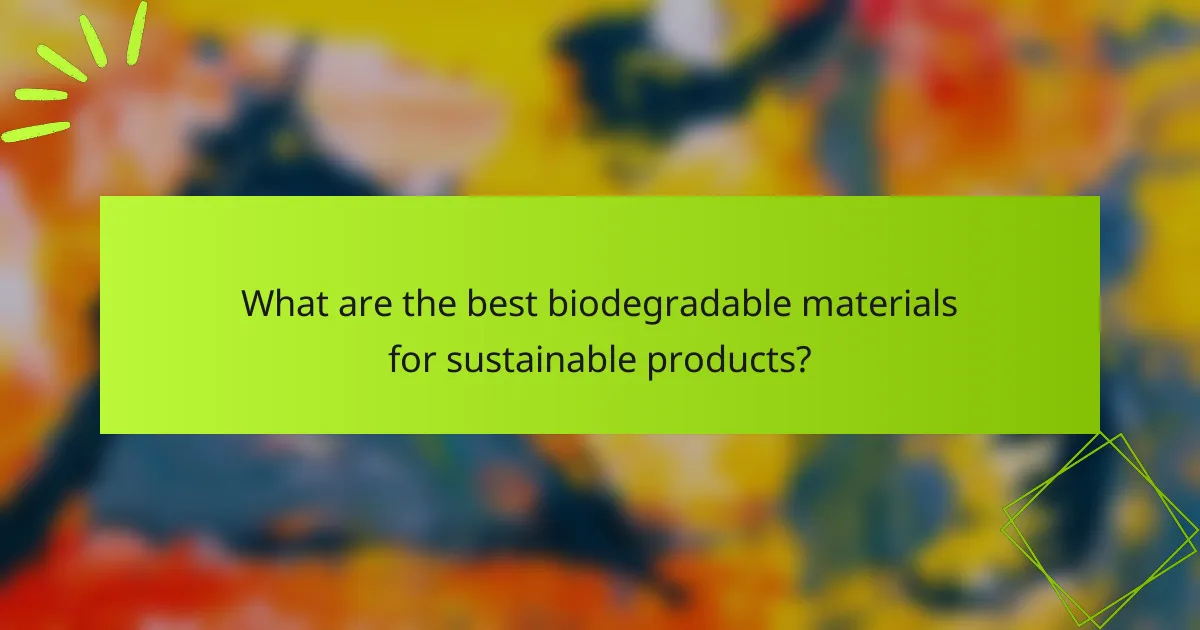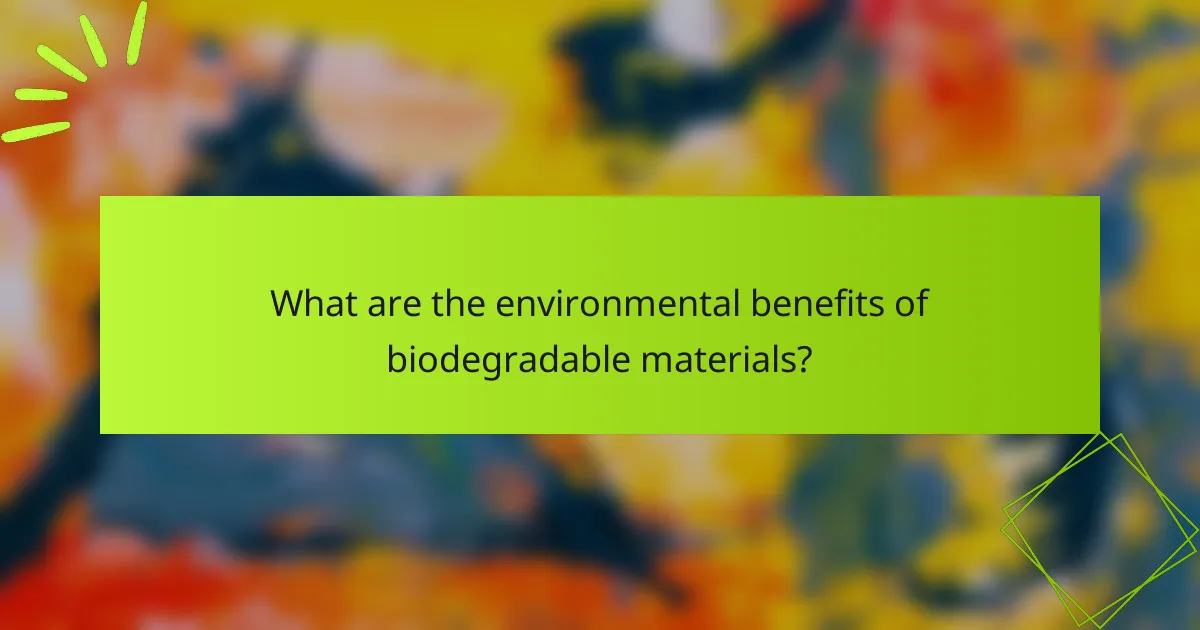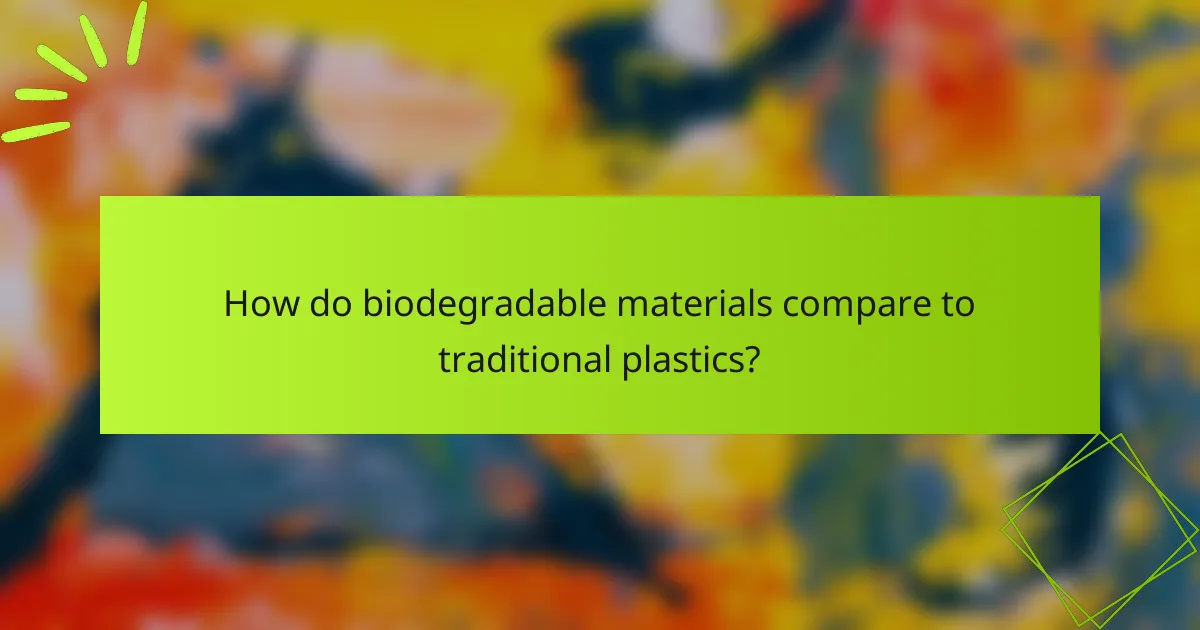Innovations in biodegradable materials are revolutionizing sustainable product design by providing eco-friendly alternatives to traditional plastics. Materials such as PLA, PHA, and starch-based plastics break down naturally, significantly reducing environmental impact and waste accumulation. As these advancements continue, they promise to meet consumer needs while promoting a healthier ecosystem.

What are the best biodegradable materials for sustainable products?
The best biodegradable materials for sustainable products include PLA, PHA, starch-based plastics, cellulose-based materials, and chitosan. These materials offer eco-friendly alternatives to traditional plastics, breaking down naturally in various environments and reducing environmental impact.
PLA (Polylactic Acid)
PLA is a popular biodegradable plastic made from renewable resources like corn starch or sugarcane. It is widely used in packaging, disposable tableware, and 3D printing due to its ease of processing and low cost.
When considering PLA, note that it requires industrial composting conditions to decompose effectively, typically needing temperatures above 60°C. This means it may not break down efficiently in home composting systems.
PHA (Polyhydroxyalkanoates)
PHA is a biodegradable polymer produced by microorganisms through fermentation processes. It is gaining traction for its versatility and ability to degrade in various environments, including marine settings.
While PHA is more expensive to produce than PLA, its superior biodegradability makes it an attractive option for applications where environmental impact is a priority. It can be used in packaging, agricultural films, and medical devices.
Starch-based plastics
Starch-based plastics are derived from natural starch sources, such as potatoes or corn. These materials can be blended with other biodegradable polymers to enhance their properties and are often used in food packaging and disposable items.
One advantage of starch-based plastics is their ability to decompose in both industrial and home composting environments. However, they may not be as durable as traditional plastics, which limits their use in certain applications.
Cellulose-based materials
Cellulose-based materials are made from plant fibers and are biodegradable and compostable. They are commonly used in packaging, films, and coatings due to their transparency and barrier properties.
These materials can break down in both soil and marine environments, making them a strong candidate for sustainable product design. However, their production can be resource-intensive, so sourcing from sustainable practices is crucial.
Chitosan
Chitosan is derived from chitin, a natural polymer found in the shells of crustaceans. It is biodegradable and has antimicrobial properties, making it suitable for food packaging and agricultural applications.
Chitosan’s biodegradability occurs in soil and aquatic environments, but its production can be limited by the availability of raw materials. It is essential to consider sourcing from sustainable fisheries to ensure environmental responsibility.

How are biodegradable materials innovating sustainable product design?
Biodegradable materials are transforming sustainable product design by offering alternatives that break down naturally, reducing environmental impact. Innovations in this area focus on creating products that meet consumer needs while minimizing waste and pollution.
3D printing with biodegradable filaments
3D printing technology has embraced biodegradable filaments, such as polylactic acid (PLA) and polyhydroxyalkanoates (PHA). These materials allow for the production of custom items that decompose over time, making them ideal for short-term use applications like prototypes and disposable tools.
When using biodegradable filaments, consider print settings that optimize material performance, such as temperature and speed. Additionally, ensure proper storage to prevent moisture absorption, which can affect print quality.
Eco-friendly packaging solutions
Innovations in eco-friendly packaging include materials like mushroom mycelium and plant-based plastics that decompose after use. These alternatives are designed to replace traditional plastic packaging, which can take hundreds of years to break down.
Brands are increasingly adopting biodegradable packaging to meet consumer demand for sustainability. When selecting packaging solutions, evaluate the entire lifecycle, including sourcing, production, and disposal methods, to ensure they align with environmental goals.
Textiles made from biodegradable fibers
Biodegradable fibers, such as organic cotton, hemp, and Tencel, are gaining traction in the textile industry. These materials not only reduce reliance on synthetic fibers but also offer a sustainable option that can decompose after disposal, minimizing landfill contributions.
When choosing biodegradable textiles, consider their durability and care requirements. Fabrics that require less water and energy during production are often more sustainable choices. Look for certifications that verify the environmental impact of the materials used.

What are the environmental benefits of biodegradable materials?
Biodegradable materials offer significant environmental advantages by breaking down naturally and reducing waste accumulation. Their use can lead to less pollution, lower carbon emissions, and a healthier ecosystem.
Reduced landfill waste
Biodegradable materials decompose over time, which helps to significantly reduce the volume of waste sent to landfills. Traditional plastics can take hundreds of years to break down, while biodegradable options typically decompose within months to a few years, depending on conditions.
By choosing biodegradable products, consumers can contribute to a decrease in landfill waste, which is crucial as many countries face landfill space shortages. This shift not only conserves space but also minimizes the environmental impact associated with waste management.
Lower carbon footprint
The production and disposal of biodegradable materials often result in a lower carbon footprint compared to conventional plastics. Biodegradable products are typically made from renewable resources, which can lead to reduced greenhouse gas emissions during their lifecycle.
For instance, using plant-based materials instead of petroleum-based plastics can cut emissions by a significant percentage. Consumers can further lower their carbon footprint by opting for biodegradable options in packaging, utensils, and other everyday items.
Less pollution in oceans
Biodegradable materials help mitigate ocean pollution by breaking down more quickly than traditional plastics, which can persist in marine environments for decades. This reduction in pollution is vital for protecting marine life and ecosystems.
When biodegradable products enter the ocean, they can decompose within a few months to a couple of years, reducing the risk of harm to marine animals that often ingest plastic debris. Supporting biodegradable alternatives can play a crucial role in preserving ocean health and biodiversity.

How do biodegradable materials compare to traditional plastics?
Biodegradable materials are designed to break down more quickly than traditional plastics, which can persist in the environment for hundreds of years. While both types of materials serve similar purposes, their environmental impacts and decomposition processes differ significantly.
Decomposition rates
Biodegradable materials typically decompose within a few months to a couple of years, depending on environmental conditions such as temperature, moisture, and microbial activity. In contrast, traditional plastics can take several decades to centuries to break down, contributing to long-term pollution.
For instance, compostable plastics can decompose in industrial composting facilities within 90 to 180 days, while some biodegradable materials may require specific conditions to degrade effectively. Understanding these rates is crucial for selecting the right material for specific applications.
Impact on wildlife
The impact of biodegradable materials on wildlife is generally less severe than that of traditional plastics, which can cause significant harm through ingestion and entanglement. However, biodegradable materials can still pose risks if they do not decompose as intended, potentially leading to ingestion by animals.
For example, if biodegradable products end up in marine environments without the right conditions for decomposition, they may still affect marine life similarly to conventional plastics. Awareness of disposal methods is essential to mitigate these risks.
Resource sourcing
Biodegradable materials are often derived from renewable resources, such as plant starches, which can reduce reliance on fossil fuels. Traditional plastics, on the other hand, are primarily made from petroleum-based products, which contribute to greenhouse gas emissions during extraction and processing.
Choosing biodegradable options can support sustainable practices, but it’s important to consider the entire lifecycle, including agricultural practices and land use for sourcing these materials. Opting for products certified by recognized standards can help ensure responsible sourcing and production methods.

What are the challenges in adopting biodegradable materials?
Adopting biodegradable materials presents several challenges, including production costs and consumer awareness. These factors can significantly impact the widespread acceptance and implementation of sustainable products in various industries.
Cost of production
The cost of producing biodegradable materials is often higher than traditional plastics, which can deter manufacturers from making the switch. This increased expense is typically due to the sourcing of raw materials, specialized processing techniques, and lower economies of scale.
For example, bioplastics derived from corn or sugarcane may cost 20-50% more than petroleum-based plastics. Companies must weigh these costs against potential long-term savings from reduced waste management expenses and increased consumer demand for sustainable products.
Consumer awareness
Consumer awareness of biodegradable materials is still limited, which can hinder market growth. Many consumers are unfamiliar with the benefits and proper disposal methods for biodegradable products, leading to confusion and skepticism.
Educating consumers about the environmental advantages of biodegradable options and how they differ from traditional plastics is crucial. Brands can leverage marketing campaigns, informative packaging, and social media to raise awareness and encourage responsible consumer behavior.

